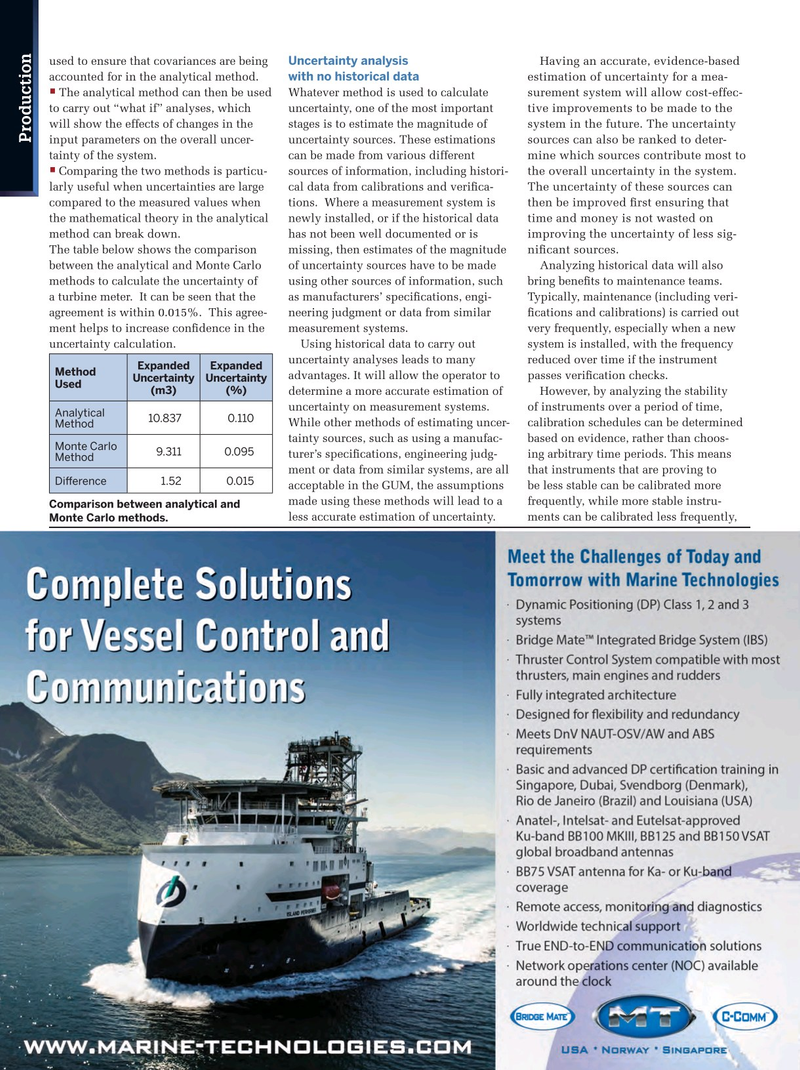
Page 50: of Offshore Engineer Magazine (Nov/Dec 2014)
Read this page in Pdf, Flash or Html5 edition of Nov/Dec 2014 Offshore Engineer Magazine
used to ensure that covariances are being Uncertainty analysis Having an accurate, evidence-based with no historical data estimation of uncertainty for a mea-accounted for in the analytical method.
• The analytical method can then be used Whatever method is used to calculate surement system will allow cost-effec- to carry out “what if” analyses, which uncertainty, one of the most important tive improvements to be made to the will show the effects of changes in the stages is to estimate the magnitude of system in the future. The uncertainty
Production sources can also be ranked to deter- input parameters on the overall uncer- uncertainty sources. These estimations mine which sources contribute most to tainty of the system. can be made from various different
Comparing the two methods is particu- sources of information, including histori- • the overall uncertainty in the system. larly useful when uncertainties are large cal data from calibrations and verifca-
The uncertainty of these sources can compared to the measured values when tions. Where a measurement system is then be improved frst ensuring that the mathematical theory in the analytical newly installed, or if the historical data time and money is not wasted on method can break down. has not been well documented or is improving the uncertainty of less sig-
The table below shows the comparison missing, then estimates of the magnitude nifcant sources. between the analytical and Monte Carlo of uncertainty sources have to be made Analyzing historical data will also methods to calculate the uncertainty of using other sources of information, such bring benefts to maintenance teams. a turbine meter. It can be seen that the as manufacturers’ specifcations, engi- Typically, maintenance (including veri- agreement is within 0.015%. This agree- neering judgment or data from similar fcations and calibrations) is carried out ment helps to increase confdence in the measurement systems. very frequently, especially when a new uncertainty calculation. Using historical data to carry out system is installed, with the frequency uncertainty analyses leads to many reduced over time if the instrument
Expanded Expanded
Method advantages. It will allow the operator to passes verifcation checks.
Uncertainty Uncertainty
Used (m3) (%) determine a more accurate estimation of However, by analyzing the stability uncertainty on measurement systems. of instruments over a period of time,
Analytical 10.837 0.110
While other methods of estimating uncer- calibration schedules can be determined
Method tainty sources, such as using a manufac- based on evidence, rather than choos-
Monte Carlo 9.311 0.095 turer’s specifcations, engineering judg- ing arbitrary time periods. This means
Method ment or data from similar systems, are all that instruments that are proving to
Diference1.52 0.015 acceptable in the GUM, the assumptions be less stable can be calibrated more made using these methods will lead to a frequently, while more stable instru-
Comparison between analytical and less accurate estimation of uncertainty. ments can be calibrated less frequently,
Monte Carlo methods.
050_OE1014_ProdOps1_NEL.indd 52 10/21/14 5:31 PM

 49
49

 51
51